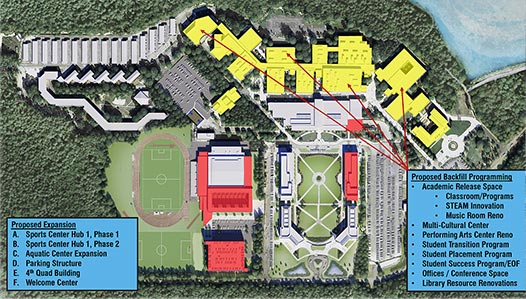Master Planning Galloway
Galloway - Space Management: Academic Spine, Arts & Sciences Building & West Quad Building
The planning and development of interior space of the academic spine (A-wing thru N-wing, plus the Arts & Sciences building, plus the West Quad) is s continuous exercise to meet the growing needs of programs for the university. These programs have included combinations of student services (such as Veteran Affairs and Women’s, Gender and Sexuality Center) and academic affairs (classrooms in C-wing, faculty office space, etc.). In addition to these spaces are the growth and development of administrative functions of the university, such as University Relations and Marketing, offices of General Counsel, Human Resources and Alumni Affairs & Development Office, etc. The university has formed a Space Management Committee to address the ongoing demand for growth and space.
When evaluating the existing academic spine (A-wing thru N-wing, plus the Arts & Sciences building, plus the West Quad), the following details include:
Existing steel frame construction, exterior masonry and metal panel wall systems, interior steel stud and drywall, acoustical ceiling tile of exposed construction, flat built up roof EPDM roof systems.
| A-wing thru N-wing | +/- 605,000SF |
| Arts & Science Building | +/- 38,000SF |
| West Quad | +/- 28,000SF |
| Total: | +/- 671,000SF |
Proposed Backfill Programming – recently submitted for review by Space Committee
- Academic Release space
- Classroom/Computer Labs/Specialty Program Space
- STEAM Innovation
- Music Room Renovations
- Multi-Cultural Center
- Performing Arts Center Renovations
- Student Transition Program
- Student Placement Program
- Student Success Programs/ EOF
- Offices / Meeting Rooms / Conference Space
- Library & Resource Center Renovations
- Counseling & Wellness Center and Learning Access Program
Classroom & Research/Creative Activity Program Space Specifications to consider in planning
These concepts are intended to evolve on a yearly basis and in accordance with the University’s strategic plan and the yearly goals and initiatives of the Academic Affairs and Office of the Provost. Examples of concepts that have been put forward by faculty, students, and students are below, noting the complexities of each academic program’s growth and evolution call for additional specific demands on current and future spaces.
- School of Natural Sciences and Mathematics (NAMs)
- Flexible program space for multi-use as a standard classroom
- Flexible storage and preparation room(s) associated with new classrooms
- STEAM Innovation program space, including access to utility
- Development and enhanced support for the Marine Science Program
- School of Arts & Humanities (ARHU)
- Maker Space (e.g., Visual Arts, interdisciplinary)
- Performing Arts, Dance
- Performing Arts, Theatre programs and practice facility
- Performing arts, Music practice and classroom space
- Performing Arts Theatre renovations
- School of Behavioral and Social Sciences (SOBL), School of General Studies (GENS),
School of Education (EDUC), and School of Business (BUSN)
- General classroom space, meeting space, small group areas, technology enhancements
- Faculty program and administrative office support spaces
- School of Health Sciences (HLTH)
- Development of new academic programs and enhanced support for existing programs: Exercise Science, Respiratory Therapy, Physical Therapy, and Occupational Therapy
- Graduate Studies
- General classroom space, meeting space, small group areas, technology enhancements



